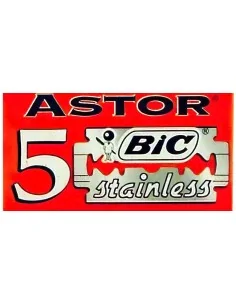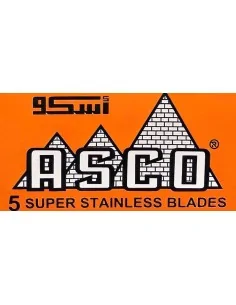- HairMaker.Gr
- Traditional Shaving
- 23 likes
- 6269 views
- 0 comments
- shaving blade, traditional shaving blade
How to Choose the Right Shaving Blade

Blade Guide Navigation
What is the difference between double edge (DE) and single edge (SE) blades?
The Big Question in Traditional Shaving
You stand in front of the mirror with your new safety razor in hand and wonder: "DE or SE blade?" This choice can make the difference between a painless shave and an irritation-filled experience. 85% of men transitioning to traditional shaving make a wrong choice initially simply because they don't understand the basic differences.
What Do DE and SE Really Mean?
The double edge razor blades have two sharp edges, one on each side of the blade. This means you can use both sides, doubling the blade's lifespan. Most safety razors on the market are designed for DE blades.
The single edge razor blades, on the other hand, have only one sharp edge. They are thicker, sturdier, and used in special SE razors like Gem or Schick Injector razors.
⚖️ The Critical Differences You Need to Know
DE Blades
- Design: Thinner (0.1mm), more flexible
- Performance: Precision work, better control
- Lifespan: 5-7 shaves (both sides)
- Cost: €0.10-€0.50 per blade
SE Blades
- Design: Thicker (0.23mm), sturdier
- Performance: Aggressive cut, fewer passes
- Lifespan: 3-5 shaves (one side)
- Cost: €0.30-€1.00 per blade
Which Choice Suits You?
Choose DE if:
- You are a beginner at traditional shaving
- You want a wider variety of options
- Looking for an economical solution
- You have sensitive skin
Choose SE if:
- You have thick, coarse hair
- You prefer a quick, efficient shave
- You want a vintage barbershop experience
- Cost is not a primary concern
Practical Advice from the Experts
- For beginners: Start with mild DE blades like Derby or Merkur
- Try sample packs: Every skin reacts differently to different brands
- SE tip: If you try SE blades, start with Gem PTFE or Personna blades
What is your experience with DE vs SE blades? Share your opinion in the comments!
What is the difference between a Feather blade and an Astra or Derby?
The "Queen" of Blades vs Classic Choices
Looking to upgrade your shave and hearing everywhere about the legendary Feather blades? Or wondering why barbers swear by Derby, while others prefer Astra? The truth is that the blade choice can make the difference between a professional shave and a frustrating experience. 78% of wet shaving enthusiasts try these three brands first before finding their "perfect" blade.
⚔️ Feather: The Japanese Precision
The Feather vs Derby blades comparison is one of the most common in traditional shaving. Feather blades are considered among the sharpest worldwide, made with Japanese precision and a special platinum coating that makes them extremely smooth.
The secret lies in their ultra-thin cutting angle (just 30 degrees) and the use of high-quality carbon steel alloys. This makes them ideal for men with tough, dense hair who need only one pass for a perfect result.
The Big Comparison: Feather vs Derby vs Astra
Feather (Japan)
- Sharpness: Extra sharp (10/10)
- Lifespan: 4-6 shaves
- For whom: Advanced users, tough hair
- Cost: €0.40-€0.60 per blade
Derby (Turkey)
- Sharpness: Moderate-soft (6/10)
- Lifespan: 5-8 shaves
- For whom: Beginners, sensitive skin
- Cost: €0.08-€0.15 per blade
Astra (Russia)
- Sharpness: Moderate-sharp (7/10)
- Lifespan: 6-9 shaves
- For whom: All levels, versatile
- Cost: €0.10-€0.20 per blade
Why Are Some Blades "Sharper" Than Others?
The Science Behind the Perfect Edge
You hold two blades in your hand – one Feather and one Derby. Both look identical, yet one cuts like butter while the other "pulls" the hair. What lies behind this difference? Sharpness is no accident – it is the result of advanced engineering, chemistry, and physics. Only 12% of users know the real factors that make one blade stand out from another.
⚗️ The Chemistry of Steel
The sharpest razor blades start with selecting the right steel. Most premium blades use high-carbon steel with a carbon content of 0.7-1.4%, offering the ideal balance between hardness and flexibility.
The critical factor is the crystalline structure of the metal. When steel is cooled under controlled conditions (tempering process), microscopic crystals form that give the edge its exceptional sharpness. This explains why Japanese blades like Feather, with their advanced metallurgy, are considered among the sharpest worldwide.
The 5 Critical Sharpness Factors
1️⃣ Bevel Angle
- Acute angle (15-20°): Extra sharp but fragile
- Moderate angle (25-30°): Balance of sharpness and durability
- Wide angle (35°+): Durable but less sharp
2️⃣ Surface Roughness
- Mirror finish: Zero friction, smooth shave
- Micro-polishing: Removes surface imperfections
- Ra value < 0.1μm: Technical sharpness standard
3️⃣ Coatings
- Platinum: Reduces friction, protects edge
- Teflon: Extra smooth glide
- Chrome: Anti-corrosive protection
4️⃣ Blade Thickness
- 0.08-0.10mm: Ultra-thin for precision
- 0.10-0.12mm: Standard thickness
- Thinner = sharper but less durable
5️⃣ Metallurgical Treatment
- Heat treatment: Optimizes hardness
- Cryogenic processing: Stabilizes structure
- Quality control: Manufacturing standards
⚔️ Shaving Blade Aggressiveness Explained
Shaving blade aggressiveness relates not only to sharpness but also the interaction with your skin:
Mild Blades (1-3/10): Derby, Merkur - Ideal for beginners and sensitive skin. Sharpness with safety.
Medium Blades (4-6/10): Astra, Personna - The golden mean for most men. Efficient without extreme risks.
Aggressive Blades (7-10/10): Feather, Kai - For experienced users with tough hair. Maximum performance, requires technique.
Expert Secrets for Maximum Sharpness
- Blade break-in: The first 2-3 uses "prepare" the edge for optimal performance
- Storage matters: Keep blades dry - moisture reduces sharpness
- Angle technique: Correct angle (30-45°) maximizes efficiency even for mild blades
- Quality control: Premium brands have stricter standards - less quality variance
Which blade gives you the ideal balance of sharpness and comfort? What’s your experience?
Which Blade Is Best for Sensitive Skin?
The Perfect Shave Without Irritation
Do you finish shaving with red spots, burning, and irritation? Do you feel like your skin "shouts" every time the razor approaches? You are not alone — 47% of men have sensitive skin, and the wrong blade choice can turn the daily routine into a nightmare. Fortunately, with the right choice, you can enjoy a smooth, comfortable shave without compromising the result.
What Does "Sensitive Skin" Mean in Shaving?
Shaving blades for sensitive skin are specially designed to reduce friction and irritation. Sensitive skin reacts strongly to mechanical pressure, blade coatings, and sharpness.
Main symptoms include razor burn, ingrown hairs, redness lasting hours, and general discomfort. The solution is not to avoid shaving, but to find the smoothest razor blade that suits you.
Top 5 Blades for Sensitive Skin
Derby Extra
- Sharpness: Mild (5/10)
- Comfort: Excellent (9/10)
- Lifespan: 6-8 shaves
- Ideal for: Beginners, daily shaving
Merkur Super
- Sharpness: Mild-Medium (6/10)
- Comfort: Very Good (8/10)
- Lifespan: 5-7 shaves
- Ideal for: Consistent performance
Personna Blue
- Sharpness: Medium (6.5/10)
- Comfort: Good (7/10)
- Lifespan: 7-9 shaves
- Ideal for: Value for money
Wilkinson Sword
- Sharpness: Mild (5.5/10)
- Comfort: Excellent (9/10)
- Lifespan: 5-6 shaves
- Ideal for: Extra sensitive skin
Astra Superior Platinum
- Sharpness: Medium (7/10)
- Comfort: Good (7/10)
- Lifespan: 6-8 shaves
- Ideal for: Transitioning to sharper blades
✅ Features to Look For
✅ Ideal Features:
- Platinum coating: Reduces friction and irritation
- Rounded edges: Less traumatic for skin
- Mild aggressiveness: Sharpness without extreme sharpness
- Consistent quality: Stable performance between blades
❌ Avoid:
- Ultra-sharp blades (Feather, Kai) at the start
- Uncoated blades
- Brands with large quality variance
Expert Tips for Sensitive Skin
- Pre-shave prep: Use pre-shave oil for extra protection
- Blade sampling: Try sample packs — every skin reacts differently
- Gentle technique: Light pressure, correct angle (30°), WTG passes only
- Post-shave care: Alcohol-free aftershave and moisturizing balm
- Blade rotation: Do not reuse blades that tug
Which blade gave you the best results for sensitive skin? Share your tips!
How Many Shaves Can You Get From One Blade?
⏱️ The Golden Question of Traditional Shaving
You look at the blade in your hand after the 5th shave and wonder: "One more time or replace it?" This decision affects not only your wallet but also your shaving quality. 73% of men change blades either too early (wasting money) or too late (suffering a bad shave). The truth is there is no "magic number" — but clear signals tell you when to replace it.
How Many Shaves Per Blade?
Blade lifespan depends on many factors, but research shows specific patterns. The how many shaves per blade mainly relies on quality, hair thickness, and shaving technique.
Generally, a quality blade lasts between 3 and 10 shaves, but for traditional wet shaving blades, the optimal range is usually 4 to 7 uses. The key is learning to recognize the signs of wear.
Lifespan by Blade Type
Ultra-Sharp (Feather, Kai)
- Average: 3-5 shaves
- Reason: Thinner edge, faster wear
- Priority: Quality > lifespan
- Cost per shave: €0.10-€0.15
Medium (Astra, Personna)
- Average: 5-8 shaves
- Reason: Balance of sharpness and lifespan
- Priority: Value for money
- Cost per shave: €0.02-€0.04
Mild (Derby, Merkur)
- Average: 6-10 shaves
- Reason: Less aggressive, longer lifespan
- Priority: Comfort + economy
- Cost per shave: €0.01-€0.02
Premium (Astra Superior Platinum)
- Average: 7-12 shaves
- Reason: Premium coating, excellent lifespan
- Priority: Maximum durability
- Cost per shave: €0.015-€0.025
⚙️ Influencing Factors
- Hair thickness: Coarser hair = fewer shaves
- Technique: Proper angle prolongs lifespan
- Frequency: Daily vs weekly shaving
- Care: Dry blade after use
Signs It Is Time to Change Your Blade
Immediate Change - Red Flags:
- Blade "pulls" hair instead of cutting
- Needing more pressure for same results
- More irritation than usual
- Uneven cut or missed spots
Warning Signs - Consider Changing:
- Shaving takes longer
- Need extra passes for a smooth result
- Blade appears visually worn or oxidized
Pro Tips for Maximizing Blade Lifespan
- Dry thoroughly: Rinse and dry the blade after every use
- Gentle technique: Let the blade do the work — avoid pressure
- Quality prep: Proper preparation reduces blade wear
- Track performance: Keep notes on each brand
- Storage: Store in a dry place, not in the shower
How many shaves do you get from your favorite blade? What techniques do you use to extend blade life?
Is There a Difference in Performance Between Japanese and German Blades?
⚔️ The Battle of Traditions: East vs West
In the world of traditional shaving, few debates are as passionate as that between Japanese and German blades. On one side, the millennia-old Japanese steel craftsmanship that created the legendary katanas. On the other, German precision and industrial perfection which dominated the West for a century. But is there truly a difference in shaving performance, or is it just marketing hype? 84% of shaving enthusiasts have tried both categories, but only 23% understand the real differences.
Manufacturing Philosophies that Shape the Result
Japanese vs German razor blades differ not only by origin country – they represent two completely different philosophies in blade manufacturing.
Japanese approach: Focus on absolute sharpness and edge perfection. Japanese blades like Feather and Kai use advanced tempering and micro-honing techniques inherited from sword making.
German approach: Emphasis on stability, durability, and consistent mass production quality. Coated vs uncoated blade technologies mostly developed in Germany aiming for mass production excellence.
⚔️ Head-to-Head Comparison: Japan vs Germany
Japanese Blades
Top Brands:
- Feather Hi-Stainless
- Kai Stainless Steel
- Dorco ST-300
Characteristics:
- Sharpness: Extra sharp (8-10/10)
- Precision: Microscopic edge accuracy
- Lifespan: 3-5 shaves
- Technique: Requires experience
- Cost: Premium pricing
Ideal for:
- Advanced users
- Tough, dense hair
- Maximum efficiency
German Blades
Top Brands:
- Merkur Super Platinum
- Muhle Stainless
- Wilkinson Sword
Characteristics:
- Sharpness: Moderate-sharp (6-7/10)
- Consistency: Excellent stability
- Lifespan: 5-8 shaves
- Technique: Forgiving, user-friendly
- Cost: Moderate pricing
Ideal for:
- Daily use
- Beginners to intermediate users
- Consistent performance
Which Tradition Should You Choose?
Choose Japanese if:
- You have at least 6 months of traditional shaving experience
- Your hair is extremely tough or dense
- You prefer fewer passes with maximum efficiency
- You are willing to pay higher prices for premium results
Choose German if:
- You want a reliable everyday solution
- You prefer comfort and forgiveness for mistakes
- You desire consistent results without surprises
- You look for good value for money ratio
The Experts' Verdict
- For beginners: Start with German blades – more forgiving and predictable
- For advanced users: Japanese blades offer unmatched precision and efficiency
- Hybrid approach: Many pros use Japanese blades for “special” occasions, German blades daily
- Try both: Skin and technique determine the ideal choice
Which tradition do you prefer and why? Have you tried blades from both schools?
Which Blade Is Ideal for Beginners to Traditional Shaving?
The First Step on Your Traditional Shaving Journey
You hold a safety razor for the first time feeling both excitement and concern. You are on the right path! Traditional shaving can transform the daily "bad head" into an enjoyable ritual, but choosing the right blade is critical. 67% of beginners quit wet shaving after their first bad experience, often due to a wrong blade choice. The good news? There are specific blades designed to teach you the art without "punishment."
What Makes a Blade "Beginner-Friendly"?
Beginner friendly shaving blades are not just "less sharp" – they are designed to offer a balanced learning experience. They feature forgiveness for technique errors, consistent performance, and predictable results.
The keys to success are: mild aggressiveness that doesn’t punish technical mistakes, smooth cutting action without pulling or tugging, and a forgiving nature that allows small errors in angle or pressure. The best DE razor blades for beginners combine all these features.
Top 5 Blades for Beginners
Derby Extra
The Ultimate Beginner Choice
- Mild Level: 4/10 – extremely forgiving
- Comfort: 9/10 – almost impossible to cut yourself
- Consistency: Very stable quality
- Lifespan: 6-8 shaves
- Cost: Budget-friendly
Merkur Super Platinum
German Reliability
- Mild Level: 5/10 – balanced
- Comfort: 8/10 – smooth performance
- Quality Control: Excellent
- Lifespan: 5-7 shaves
- Cost: Mid-range
Personna Blue
Value Champion
- Mild Level: 5.5/10 – slightly sharper
- Comfort: 7/10 – good for the price
- Longevity: Excellent
- Lifespan: 7-9 shaves
- Cost: Very economical
4️⃣ Astra Superior Platinum
Versatile Performer
- Mild Level: 6/10 – great for "graduation"
- Comfort: 7/10 – balanced approach
- Progression: Good for advancement
- Lifespan: 6-8 shaves
- Cost: Affordable
5️⃣ Lord Super Stainless
Budget Friendly Starter
- Mild Level: 4.5/10 – very mild
- Comfort: 8/10 – extremely gentle
- Learning curve: Ideal for learning
- Lifespan: 5-7 shaves
- Cost: Very economical
⚠️ Blades to Avoid as a Beginner
❌ Red Zone – Do Not Try First:
- Feather Hi-Stainless: Extra sharp – for experts only
- Kai Stainless: Japanese precision that does not forgive
- BIC Chrome Platinum: Unpredictable quality
- Shark Super Stainless: Aggressive and inconsistent
⚠️ Use With Caution – Try After 2-3 Months:
- Gillette Silver Blue: Good but requires technique
- Polsilver Super Iridium: Smooth but more aggressive
Beginner Success Guide
- Start small: Buy a sample pack with 5-10 mild blades
- One blade, one week: Try each blade for 5-7 shaves
- Keep notes: Track comfort, efficiency, irritation levels
- Master technique first: Perfect angle and pressure before switching blades
- Gradual progression: After 3 months, try sharper options
What was your first blade in traditional shaving? What advice would you give a beginner?
How to Choose the Right Blade for Your Razor Type?
The Perfect Match: Razor + Blade Synergy
You have a great safety razor but the shave isn’t satisfying? The issue may not be the razor but a wrong "pairing" with the blade. Each razor has its own character—from exposure angle to blade gap—and requires a specific blade type to perform at maximum. 71% of users don’t realize the same blade can be perfect on one razor but disappointing on another. Let's uncover the science behind a perfect pairing!
Understanding Razor Design
To choose the right blade, you first need to understand your razor’s characteristics. The how to choose razor blade for safety razor principles rely heavily on razor geometry.
Blade Gap: The distance between the guard and the edge. Larger gap = more aggressive razor needing milder blades; smaller gap = milder razor that can handle sharper blades.
Blade Exposure: How much the blade edge protrudes. Negative exposure = very mild, Neutral = balanced, Positive = more aggressive. This directly affects blade choice for safety razor blade differences.
⚖️ Razor Types & Ideal Blades
Mild Razors
Examples: Merkur 34C, Edwin Jagger DE89, Feather Popular
Characteristics:
- Blade gap: 0.5-0.7mm
- Negative/neutral exposure
- Forgiving for beginners
Recommended Blades:
- Feather Hi-Stainless (for efficiency)
- Gillette Silver Blue
- Polsilver Super Iridium
- Kai Stainless Steel
Medium Razors
Examples: Merkur Progress, Rockwell 6S (Plate 3-4), Parker 99R
Characteristics:
- Blade gap: 0.7-1.0mm
- Neutral exposure
- Versatile performance
Recommended Blades:
- Astra Superior Platinum
- Personna Blue/Red
- Gillette 7 O'Clock (Yellow/Green)
- Voskhod
Aggressive Razors
Examples: Mühle R41, Fatip Grande, Rockwell 6S (Plate 5-6)
Characteristics:
- Blade gap: 1.0mm+
- Positive exposure
- Maximum efficiency
Recommended Blades:
- Derby Extra
- Merkur Super Platinum
- Wilkinson Sword
- Crystal Super Platinum
Adjustable Razors
Examples: Gillette Slim/Fatboy, Merkur Futur, Parker Variant
Advantages:
- Adjustable blade gap
- Allows “tuning” the blade
- Ideal for experimentation
Strategy:
Start with mild setting + sharp blade, or aggressive setting + mild blade. Find your sweet spot!
Testing & Fine-Tuning Process
Step 1 - Identify Your Razor Type:
- Measure blade gap with feeler gauges
- Check blade exposure
- Consult manufacturer specs
Step 2 - Start with “Opposite” Blades:
- Mild razor = Sharp blades (Feather, Kai)
- Aggressive razor = Mild blades (Derby, Merkur)
- Medium razor = Balanced blades (Astra, Personna)
Step 3 - Fine-tune:
- Too aggressive = try milder blade
- Not efficient enough = try sharper blade
- Too much irritation = try smoother blade
Pro Matching Secrets
- Opposite attraction rule: Mild razors + sharp blades, aggressive razors + mild blades
- Blade stiffness matters: Flexible razors need stiffer blades (e.g. Kai)
- Head design counts: Closed comb = smoother blades, Open comb = any blade works
- Personal factor: Thick beard = priority on sharpness over comfort
- Season adjustment: Use milder combos in winter (dry skin)
What is your favorite razor-blade combo? How did you find your perfect match?
Are There Coated Blades and What Does That Mean?
The Invisible Technology That Changes the Game
You look at two blades and they seem identical, but one costs twice as much. Why? The secret lies in an ultra-thin coating – just 0.001mm thick – that can make the difference between a smooth, effortless shave and an experience full of tugging and irritation. 89% of premium blades on the market use some form of coating, but only 34% of users understand what it really offers. Let’s reveal the science behind these high-tech coatings!
⚗️ What Are Blade Coatings?
Coated vs uncoated blades differ not only in performance but also in manufacturing technology. Coatings are ultra-thin layers of materials applied to the blade edge using advanced processes like Physical Vapor Deposition (PVD) or Chemical Vapor Deposition (CVD).
These microscopic coatings act as a "lubricant layer" between the blade and the skin, reducing friction by 40–60%. Additionally, they protect the edge from oxidation and wear, extending its lifespan. A traditional razor blade guide should cover these technological differences.
Types of Coatings & Characteristics
Platinum Coating
The Gold Standard of Coatings
Features:
- Reactivity: Zero – doesn’t oxidize
- Smoothness: Excellent friction reduction
- Longevity: Lasts the entire blade’s life
- Hypoallergenic: Ideal for sensitive skin
Brands: Astra Platinum, Gillette Platinum, Personna Platinum
Teflon/PTFE Coating
Ultimate Slippery Surface
Features:
- Low friction: The smoothest glide
- Chemical resistance: Impervious to shaving creams
- Temperature stable: Stable under all conditions
- Easy rinse: Doesn’t trap hairs or soap
Brands: Feather Hi-Stainless, Gem PTFE, Wilkinson Sword
Chrome Coating
Classic Protection
Features:
- Corrosion resistance: Protects against oxidation
- Hardness: Increases edge durability
- Mirror finish: Smooth surface
- Cost effective: Budget-friendly option
Brands: BIC Chrome Platinum, Gillette Silver Blue, Derby
Multi-Layer Coatings
Premium Technology
Features:
- Hybrid benefits: Combines multiple advantages
- Optimized performance: Tailored to specific applications
- Extended life: Maximum lifespan
- Premium pricing: High-end segment
Brands: Polsilver Super Iridium, Gillette Nacet, Kai Stainless
⚔️ Coated vs Uncoated: The Ultimate Comparison
✅ Coated Blades
Advantages:
- Smooth glide, less friction
- Longer lifespan
- Less irritation
- Better for sensitive skin
- Protection against oxidation
Disadvantages:
- Higher cost
- Can "mask" poor technique
- More processing during production
❌ Uncoated Blades
Advantages:
- More affordable
- Pure steel cutting action
- "Honest" technique feedback
- Traditional shaving experience
- Simpler construction
Disadvantages:
- More friction
- Faster wear
- More difficult for beginners
- Risk of oxidation
When to Choose Each Type
Choose Coated if:
- You have sensitive skin
- You shave daily
- You prioritize comfort over cost
- You want consistent performance
- You seek maximum blade life
Choose Uncoated if:
- Budget is a priority
- You prefer a traditional feel
- You're aiming to improve technique
- You have tough or resilient skin
- You enjoy the “raw” cutting feedback
Do you prefer coated or uncoated blades? What difference do you notice in performance?
Frequently Asked Questions (FAQs)
Which Blade Is Best for Daily Shaving Without Irritation?
The Holy Grail of Daily Shaving
You wake up every morning and your first thought is: "Shaving again..." Instead of enjoying it, it feels like a chore. The solution lies in choosing the right blade for daily use. Daily shaving has different needs than a weekly grooming session — it requires consistency, comfort, and zero drama. 82% of men who shave daily report irritation, but the right blade can turn this obligation into a satisfying morning ritual.
Criteria for the Ideal Daily Blade
The best razor blade for coarse beard when used daily must balance effectiveness with comfort. Daily shaving means less stubble per session, so extreme sharpness isn’t necessary.
Key characteristics: Consistent performance without "bad days," forgiving enough for sleepy hands, smooth cutting action that doesn’t irritate already-sensitive skin, and reasonable longevity for cost-efficiency. These are the traits that make the best razor blades for barbers also ideal for home use.
Top 5 Champions for Daily Shaving
Astra Superior Platinum
The Daily Driver Champion
Why it’s #1:
- Sweet spot balance: 7/10 sharpness, 8/10 comfort
- Consistency: Same performance every day
- Platinum coating: Smooth glide, less irritation
- Longevity: Reliable for 6–8 shaves
- Price: Excellent value for money
Gillette Silver Blue
Premium Daily Experience
Why it stands out:
- Ultra-smooth: Most comfortable cutting
- No pulling: Even on daily stubble
- Professional grade: Barber-approved
- Forgiving: Allows small technique errors
- Duration: 5–7 solid shaves
Personna Blue
Budget Daily Hero
Why it delivers:
- Amazing value: Costs just €0.02/shave
- Long-lasting: 7–9 shaves
- Reliable: Consistent quality
- Mild character: Perfect for sensitive skin
- Availability: Easy to find
Merkur Super Platinum
German Engineering
Why it’s trusted:
- Predictable: No surprises, always consistent
- Quality control: Flawless finish
- Balanced: 6/10 sharpness, 8/10 comfort
- Versatile: Works with all razors
- Professional: Trusted by barbers
⚠️ Blades to Avoid for Daily Use
❌ Not recommended for daily shaving:
- Feather Hi-Stainless: Too sharp – high risk of irritation
- BIC Chrome: Inconsistent quality, unpredictable
- Shark Super Stainless: Too aggressive for daily use
- Treet Platinum: Cheap but unreliable performance
⚠️ Use with caution – only if you have experience:
- Polsilver Super Iridium: Excellent but demands skill
- Kai Stainless: For advanced users only
✨ Your Daily Shaving Formula
- Warm face rinse: Softens skin and opens pores
- Use pre-shave oil: Extra lubrication and protection
- Apply shaving cream or soap: With a quality brush
- Use a forgiving blade: Astra SP, Gillette SB, or Personna Blue
- Short, smooth passes: Don’t rush
- Rinse with cold water: Tightens pores
- Use alum block (optional): Closes nicks and tones skin
- Apply aftershave balm: Hydrates and calms skin ✅
Weekly Blade Maintenance Tips
- Disassemble your razor: Clean it with warm water and a soft brush
- Dry the blade: Gently pat it with a towel to avoid rust
- Inspect edges: If you see corrosion or wear, replace it
- Store dry: Keep it in a ventilated area, never inside a closed cabinet
Choose your blade like you choose your watch: for reliability, elegance, and comfort. Daily shaving shouldn’t hurt — it should empower. ?✨
Next Articles
Get 10% Off Your First Order!
Subscribe to our newsletter and receive hair care tips, new arrivals, and exclusive offers straight to your inbox.
- ✔️ No spam – ever.
- ✔️ You choose what you want to receive.
- ✔️ 10% discount on your first purchase.
Only benefits. No fuss.

Giannis – Owner of HairMania Greece & Founder of HairMaker.Gr
Professional hairstylist with 25 years of experience in both men's and women's grooming. Owner of HairMania Greece and founder of HairMaker.Gr.
Alongside the HairMaker.Gr team, I publish content based on real salon tests, client feedback, and hands-on professional experience.
Got questions about hair care or grooming? Email us at info@hairmaker.gr.
Follow us:
@hairmakergr | @hairmaniagr
Reviewed and verified by Giannis – Professional hairstylist with 25 years of experience












Comments (0)